Description
General usage conditions - for industrial and commercial usage in conditions of high humidity (0-95%, non-condensing). The device is not intended for domestic use. |
NetPing 8 IP PDU GSM3G R7 device belongs to the IP PDU (IP power distribution unit) class of devices with ATS (Auto Transfer Switch). These power distribution units allow remote turning on, turning off and restarting the equipment by managing 100V … 240V AC, 50/60 Hz sockets, as well as to measure the active power consumption for each outlet and automatically switch the power supply input to the backup one.
Applicable solutions:
- Restart the modems, access points, switches, routers, servers and other computer equipment that freezes with no need to access it physically. If a network is unavailable, this operation can be fulfilled via an SMS command. This allows to minimize efforts and expenses on a huge amount of trips to turn on/turn off/reload a hung-up hardware.
- Remote turning on/off the additional computer equipment. Physical turning on of a backup servers, switches, routers, and access points can be done as needed, in a manual or automatic mode (as well as turning them off when there is no more such need). This allows to save electricity and reduce equipment wear out, because its work is required sometimes or in certain periods of time.
- Switch to a backup power supply input. Switching to a backup input can be fulfilled automatically, when a voltage disappears on the main input; it’s also possible to set up the priority input.
- Remote turning on/turning off conference call displays, internet cafe or play centers displays. Displays can be managed both via Ethernet/Internet network and via SMS commands.
- Remote management of air conditioners, ventilation systems and climate control systems. Connected sensors allow current situation surveillance, and a remote 100V … 240V AC, 50/60 Hz sockets management allows turning on a necessary system with no physical presence on an object, including automatic mode.
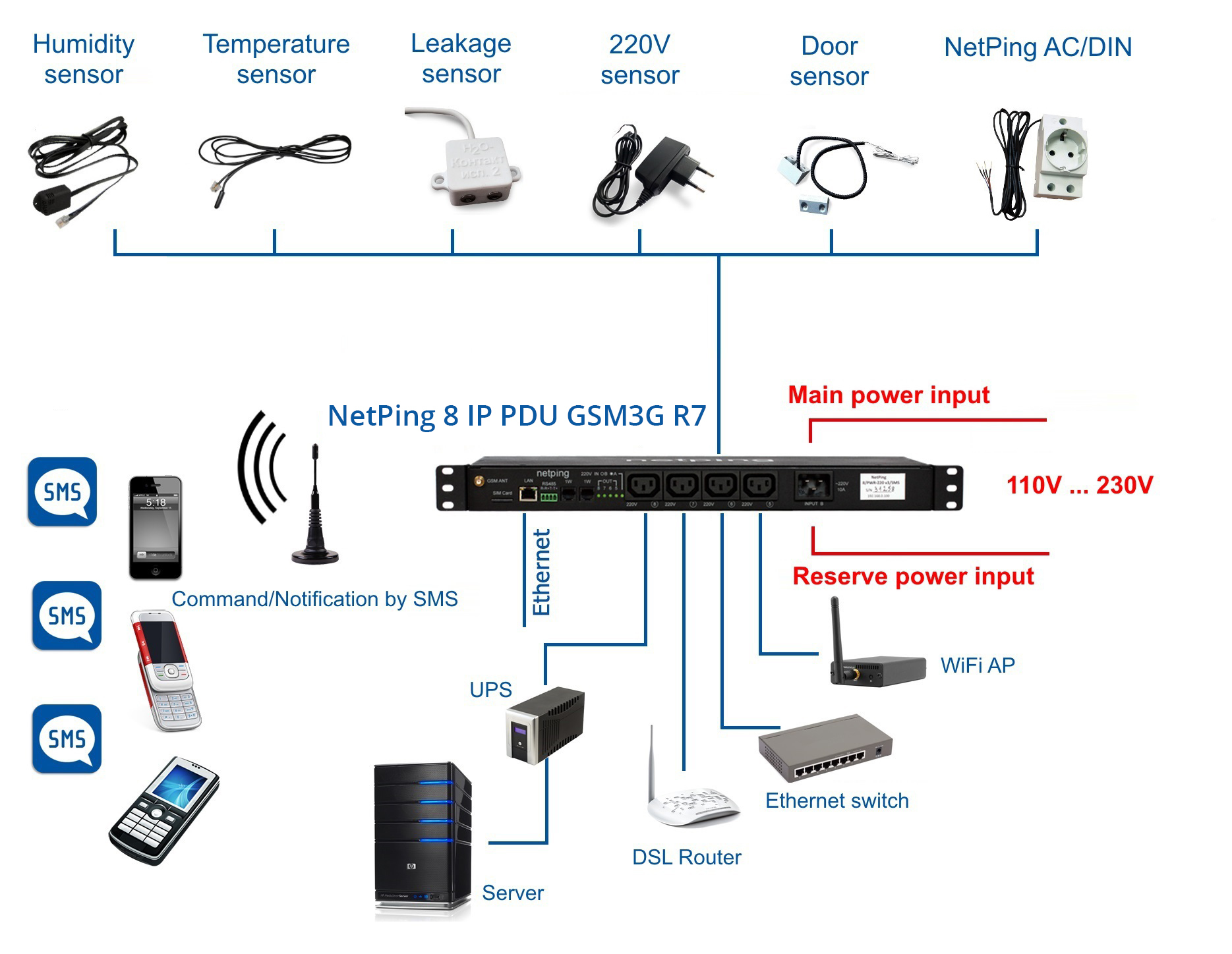
NetPing 8 IP PDU GSM3G R7 power supply sockets and inputs management
Remote management of device sockets via the Ethernet/Internet network
Each output socket of NetPing rack power distribution unit can be remotely switched on/switched off/restarted. Sockets can be managed through a built-in web interface, with the help of any browser or using SNMP commands.
Sockets remote management via SMS messages
Any socket can be switched on/off or restarted via SMS message. It allows to control a power supply of a connected device even when the Ethernet/Internet network is down or unavailable.
A watchdog for automatic reloading of an external equipment
If any external device, a router or an access point freezes sometimes, NetPing rack power distribution unit can automatically restart these devices. To do this, it constantly polls the specified IP addresses by the ping protocol. If it gets no response, it will automatically restart the connected device by turning off and turning on its power supply.
Switching on/off sockets on a schedule
NetPing rack power distribution unit can switch on and off a voltage on its built-in sockets on its own on a weekly schedule, switch on/off a voltage several times a day, use a special schedule for holidays. This may be useful for a daily/weekly forced reboot of external devices or for turning off unused equipment in a certain time of a day.
Automatic switching from a main power supply input to a backup one
When a power supply disappears on a main input, NetPing rack PDU can automatically switch all sockets to powering from a backup input. When a power supply on a main input is recovered, NetPing rack PDU can automatically switch sockets to a main input. Switching time between two inputs is several seconds, and for this period of time sockets of a device will be cut off power.
The device also provides an algorithm for an automatic selection of an operating power input.
An algorithm for switching the 220–240V network:
|
Condition |
Main input |
Backup input |
Power supply load |
|
Normal voltage |
Above 220V -25% and Below 220V +30% |
Any |
Main |
|
Reduced voltage |
Below 220V +25% |
Above 220V -25% |
Main → Backup |
|
Both are reduces |
Below 220V +25% |
Below 220V +25% |
The highest voltage is selected, hysteresis 20–30%; The frequency of switching – 1 time per 5–7 s |
|
Recovery after reduction. The backup has been turned on |
Above 220 V -25% |
Any |
Main The delay of switching – 0.5 s after the voltage is on |
|
Overvoltage |
Above 220V + 30% |
Above 220V + 30% |
If there is voltage, the input turns off. It is allowed to disable both inputs |
|
Recovery after overvoltage |
Below 220V +30% |
Below 220V +30% |
Transition to any input where the voltage is within appropriate values The delay of switching – 0.5s after the voltage reduction |
When the algorithms are triggered, the ABP performs actions in several modes.
When the algorithms are triggered, the ABP performs actions in several modes.
The order of the AVR operation when the voltage drops at one input:
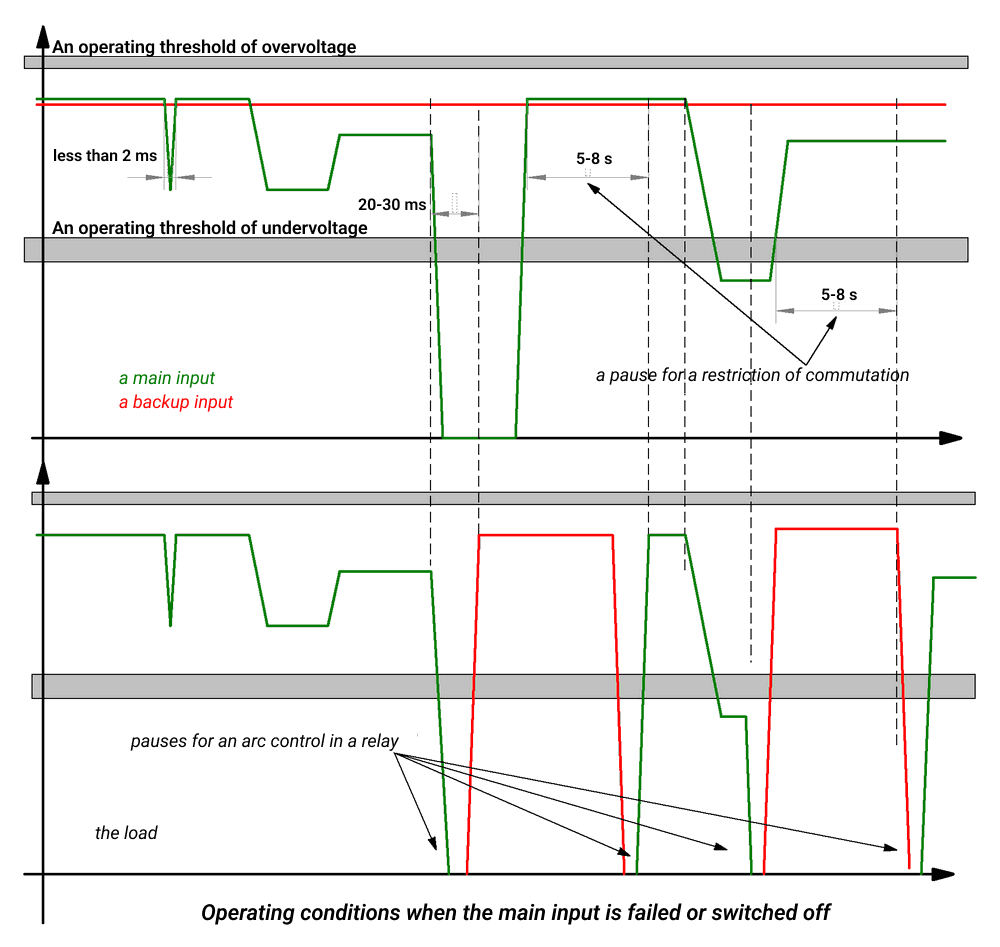
The order of the ABP operation when the voltage drops at two inputs:
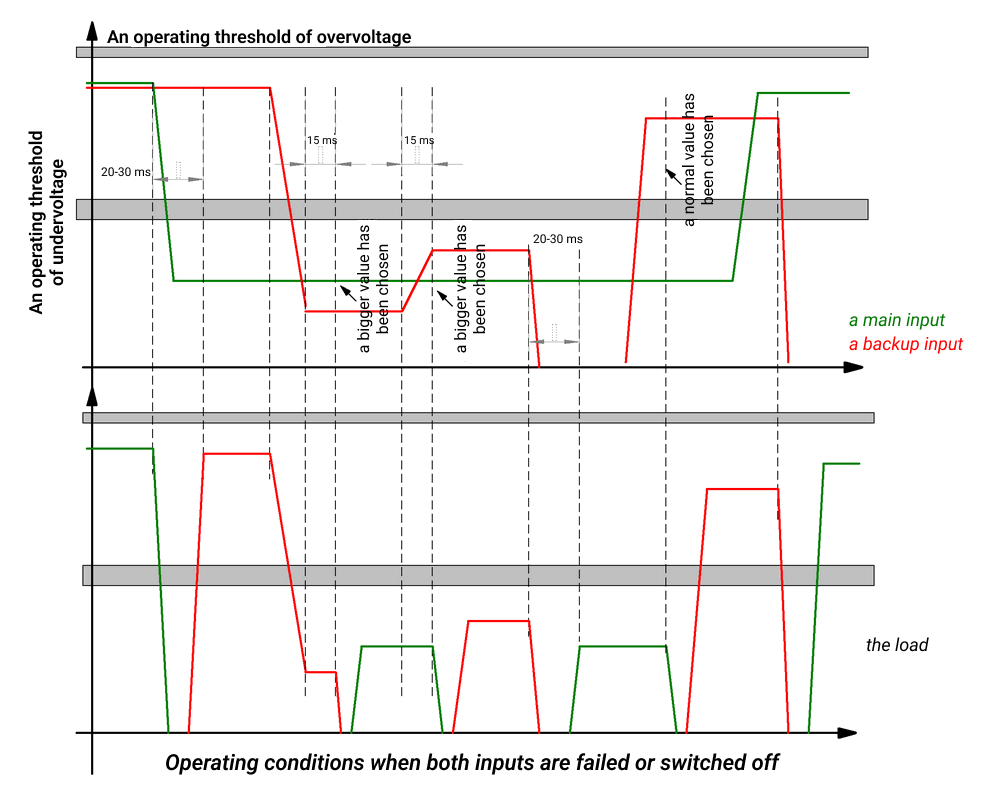
The order of the ABP operation with an increase in voltage:
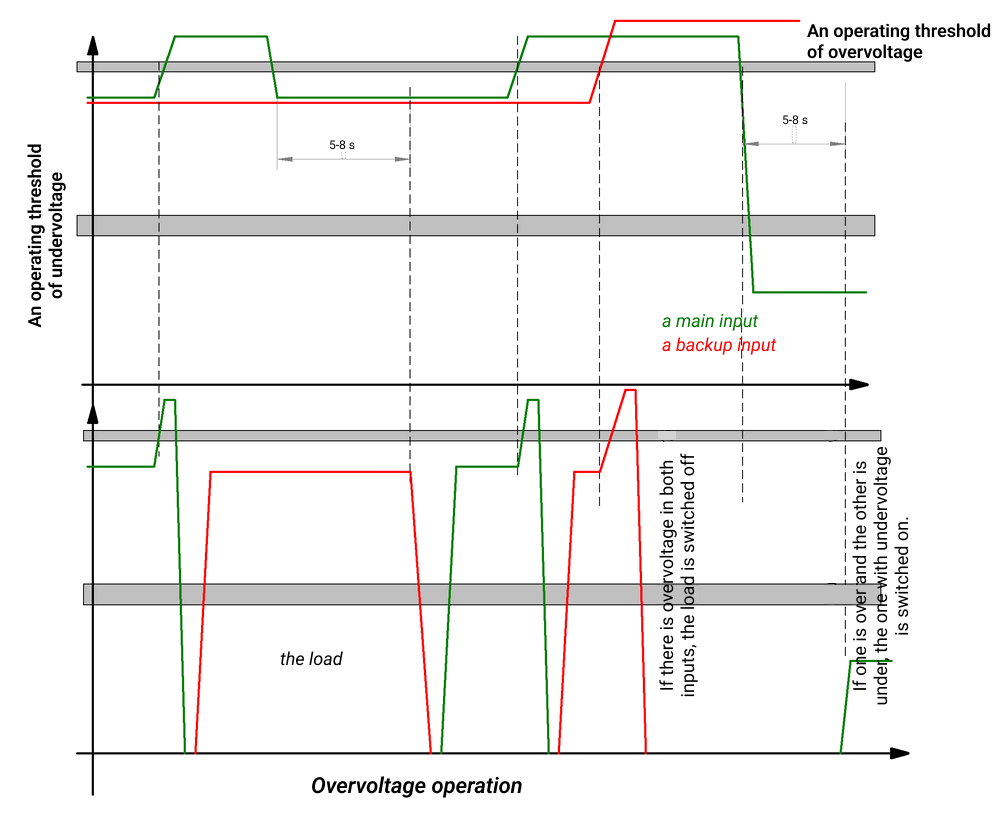
ATS for two power inputs
The device operates with two independent power inputs (2 Euro plugs for a connection to the power supply network). It can be powered from any of these inputs. The sockets of the device can be powered from any of the power inputs. It makes possible to select a priority power source for connected loads remotely. For example, one power input can be the main one, and the second one is a backup (a diesel generator). When these is a power failure at the main power input, all sockets can be switched to the backup input.
DO NOT switch priority more than once every 10 s.
NetPing 8 IP PDU GSM3G R7 pluggable sensors and monitoring functions:
Email, SNMP TRAP, Syslog notifications about sensors triggering
When sensors, connected to NetPing rack power distribution unit, are triggered, the rack PDU can send the next notifications:
Email – a rack PDU can send Email messages directly through an SMTP server. Both notifications about sensors triggering and periodical reports about sensors status are sent via Email.
SNMP TRAP – is convenient to use for integration with monitoring systems as well as for fulfilling automatic actions on a PC (for example, start playing an alarm) with the help of specific software.
Syslog – with the help of specific software installed on a PC (a syslog server), all messages from sensors can be stored in a text file for a following analysis.
SMS notifications from sensors
When a sensor is triggered, NetPing rack power distribution unit can send an SMS notification to an indicated phone number. It is convenient to use for the most critical sensors. A responsible employee will receive a notification to his/her cell phone regardless his/her location and Internet access. In addition, the notification does not depend on an Ethernet/Internet access/connection of the rack PDU.
Temperature sensors
External temperature sensors are extremely popular in monitoring systems. With their help, it is possible to control a temperature mode of a critical equipment operation as well as receive timely notifications about denials and failures in a climate control system, diagnose coolers failures and accidental ventilation flows overlaps.
Humidity sensors
It allows to estimate a relative humidity of atmospheric air. It is commonly used to monitor optimum conditions of a computer equipment operation in server rooms or data center.
Supply voltage sensor
This sensor allows to detect a presence or an absence of voltage in a power supply socket, to which a sensor is connected. A common use of this sensor is to receive notifications when a voltage in the electrical network disappears. At the same time, NetPing rack PDU must be powered by UPS or a battery, or a backup power line.
Door opening/closing sensors
It performs security and monitoring functions. It helps to track opening/closing of a door into a server room, data center or the same of a door to a switch cabinet with equipment.
Leakage sensors
Allows to determine a water on a floor of a server room, data center or on a bottom of a wiring closet. In a case of flooding (a breakage in a water or heating system) this sensor allows to give advance notice to a responsible employee about a contingency. Also this sensor can be useful to control leakage in a conditioner condensing system.
Usability, simple integration into existing systems, reliability:
Works 24 hours/7 days a week, with no hang-ups
NetPing rack PDU is designed for an uninterrupted operation in an unattended room in 24/7 mode. A built-in power supply supervisor protects a power distribution unit from hang-ups when there are voltage fluctuations. We do not use operating systems when developing software. The entire code is written by us on a C language completely, and the code is highly optimized for the provided functionality.
An embedded web server
NetPing rack PDU is managed and configured through a browser. Specific software is not needed. Operates in any OS (Windows, Linux, Mac).
Connecting to an Ethernet network, a static IP address
Rack PDU is connected to a common office Ethernet network, into any available port of an Ethernet switch. Having published an IP address of a device in the Internet, it is possible to manage device sockets from anywhere in the world.
2 Ethernet ports on a body of a device
They allow using one port to connect a rack power distribution unit to an Ethernet switch, and the second one as a common Ethernet port to plug any Ethernet devices, including other NetPing server room monitoring units and power distribution units, in a chain. This can be extremely useful when all ports of a switch are already occupied: NetPing can be plugged into a switch, and a network device can be plugged into an available Ethernet port.
Authorization and access restriction
An access to a web interface of a rack PDU is protected with a login and password, set by a user. There is a need to authorize to get to a web interface of a device. Besides, it is possible to restrict an access to a device, having left an access from a specified IP sub network only.
SNMP support
An SNMP protocol is widely used in data collection systems for network equipment. A power distribution unit supports management commands as well as receives information from sensors via an SNMP protocol. A rack PDU is easily integrated with network monitoring systems, such as Zabbix, PRTG Network Monitor, Nagios, OpenNMS, Monit, The Dude, LibreNMS, SolarWinds Orion Platform and similar ones, which receive data on a status of sensors, connected to a device through an SNMP protocol.
Syslog support
This protocol together with dedicated server software can be used for collecting text log files of different devices operation in a network, including NetPing power distribution units. This can be very useful for collecting and analyzing statistics.
URL-encoded commands support
A rack PDU supports sockets management and receiving information from sensors with the help of specific HTTP commands. These commands allow managing a device from any web page, developed by a user, including any mobile application.
Firmware update
A rack PDU supports updating firmware through a web-interface of a device. We occasionally release updates for firmware. The updates are free of charge.
Nonvolatile log file
All events (turning devices on and off, information from sensors) are stored in a nonvolatile memory. The information is stored even when a power supply cuts off.
Nonvolatile clock and time synchronization with NTP
To execute commands in a fixed specific time (a module Schedule), it is crucially important for a clock not to shift. Time tags are used for records in a log file as well. A device has its own built-in nonvolatile clock and a possibility to automatically sync with external time server via an NTP protocol.
Automation on a basis of NetPing 8 IP PDU GSM3G R7:
Automation and logic rules execution (LOGIC)
A rack power distribution unit allows setting certain logic rules, which will be executed by a device automatically. For example, to switch on a voltage, to turn on a notification alarm or a signal lamp, when a temperature on a temperature sensor exceeds indicated values, and automatically turn off a notification when a temperature is back to normal. Such rules allow implementing a simple automation system on a basis of a device.
Automatic management of external devices via SNMP
Embedded logic rules allow managing other NetPing rack power distribution unit through a network by sending them a SNMP SET command when a condition works. It can be useful to turn on an indication/notification in another building when a sensor is triggered in a server room, for example. Regardless a device with a sensor location as well as an indication device location, a command will be executed if they have a network connection.
Connecting controlled power supply sockets NetPing AC/DIN
If there is a need to control a power supply of the external load, it is possible to connect an external controlled power supply socket NetPing AC/DIN to a rack PDU. Such controlled socket allows to switch on, switch off and reload a power supply of the external load 100V … 240V AC, 50/60 Hz, with a current up to 10A.


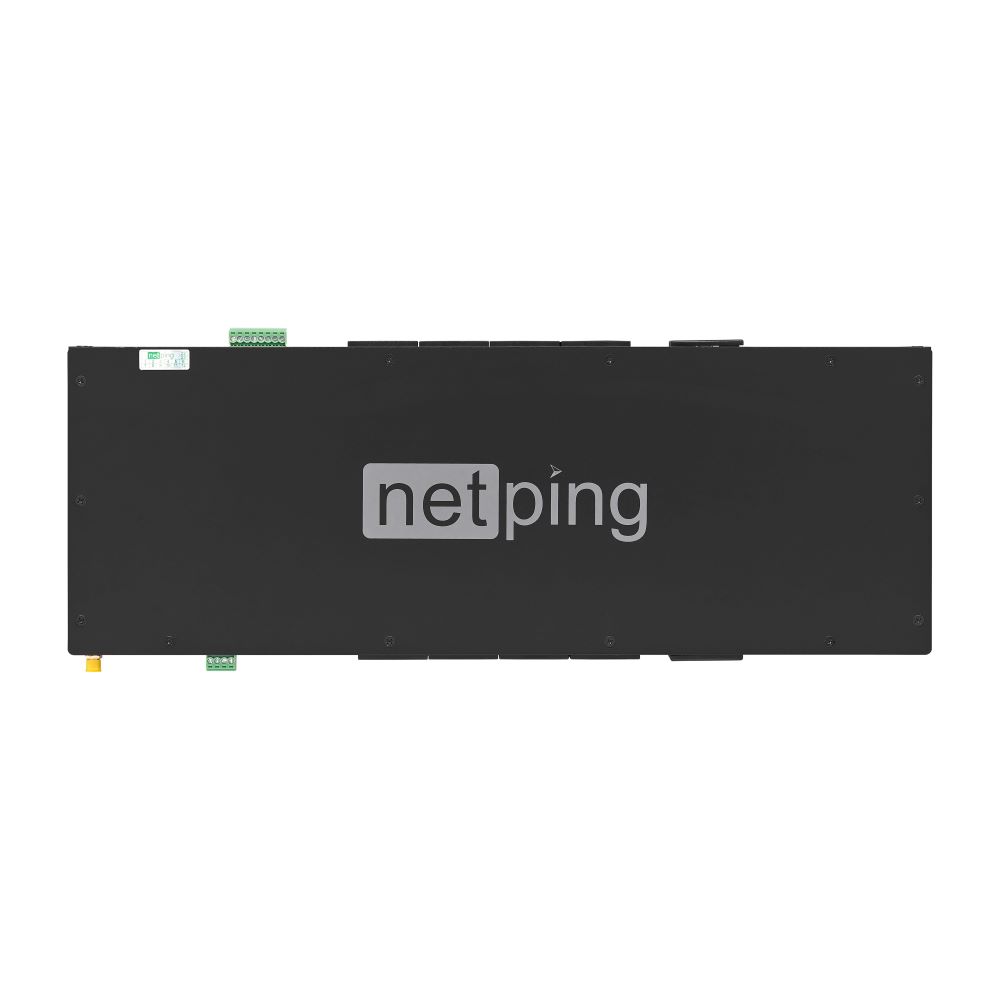
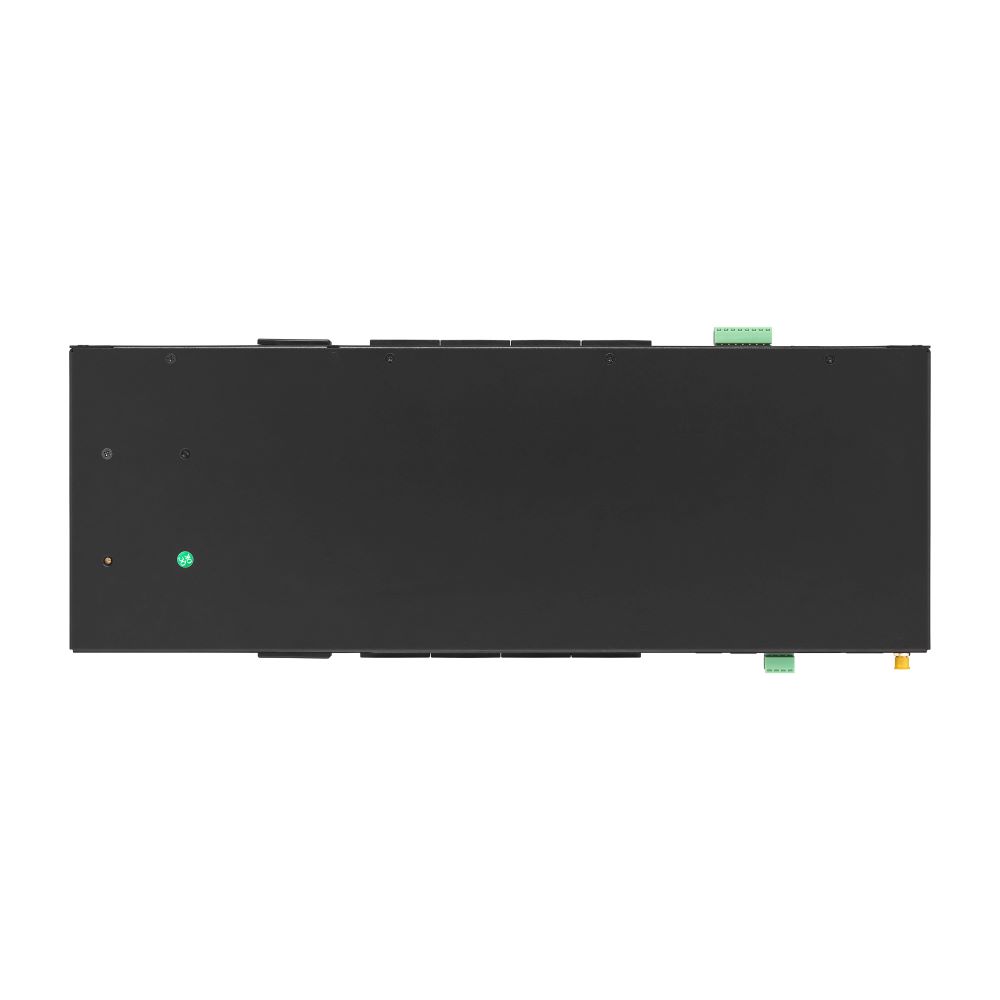
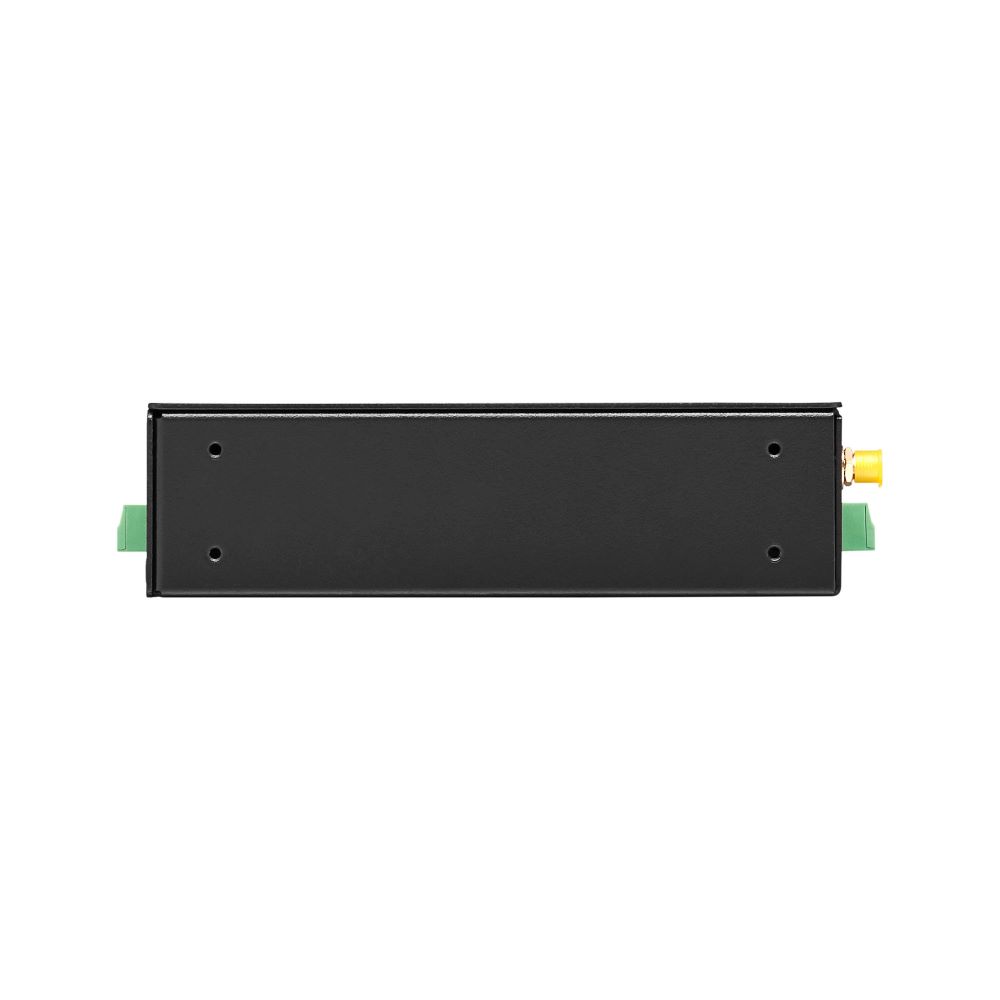
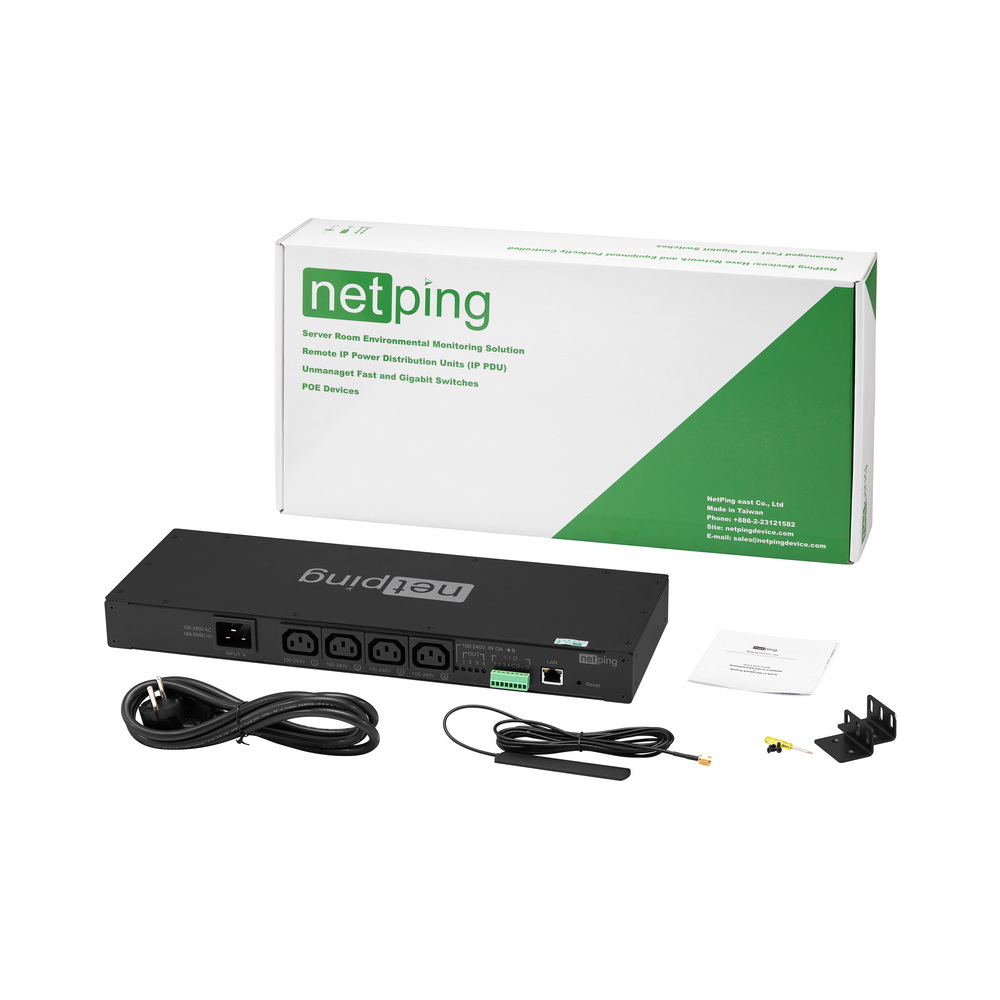

 Cable 4 extender, 4m
Cable 4 extender, 4m  Cable extender 1-wire, 10m
Cable extender 1-wire, 10m  Cable extender 1-wire, 2m
Cable extender 1-wire, 2m  Cable extender 1-wire, 5m
Cable extender 1-wire, 5m  FLWS-60BSL
FLWS-60BSL  GLS Humidity sensor 1-wire (HS)
GLS Humidity sensor 1-wire (HS)  NetPing 1-wire hub R912R2
NetPing 1-wire hub R912R2  NetPing AC/DIN
NetPing AC/DIN  NetPing Supply Voltage Sensor 995S2
NetPing Supply Voltage Sensor 995S2  PIR DETECTOR (mod.M105-1E)
PIR DETECTOR (mod.M105-1E)  Temperature sensor 1-wire, (THS)
Temperature sensor 1-wire, (THS)